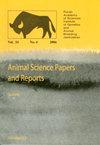健康受试者口腔真菌群中白色念珠菌纳米力学特性的评估——一项初步研究
IF 1.1
4区 农林科学
Q3 AGRICULTURE, DAIRY & ANIMAL SCIENCE
引用次数: 0
摘要
在健康的生理状态下,口腔粘膜为念珠菌的定植创造了适宜的环境。该研究的目的是分析在实验室条件下产生的生物膜中来自健康人口腔的白色念珠菌细胞的纳米力学特性。从健康个体的口腔中取样念珠菌。利用扫描电镜(SEM)对生物膜的形成过程进行了分析,并利用原子力显微镜(AFM)技术对细胞的纳米力学性能进行了评价。从健康人群口腔采集的所有分离菌株中检出79%的白色念珠菌。其他孤立的物种属于“非白色念珠菌”群。对白色念珠菌进行24小时培养的观察显示,细胞有形成多层细胞系统的生物膜结构的趋势。该结构的白色念珠菌细胞直径为5.75µm,假菌丝长度为17.08µm。检测到白色念珠菌细胞周围存在细胞外物质。测定的白色念珠菌细胞粘附力平均值为4.01 nN。硬度增加的区域(力调制模式信号;FMM信号主要出现在与玻璃基板接触的细胞区域。液体样品中念珠菌细胞的分析结果令人满意,因为它防止了细胞表面的不利变化,从而提供了更可靠的结果。生物膜的质量可能与白色念珠菌细胞的纳米力学特性有关,因此可能有助于生物膜结构的稳定性及其对抗真菌药物的敏感性或耐药性。念珠菌的存在,特别是在伴侣动物(狗、猫)中,有传播给人类有机体的风险。因此,建议开展进一步的研究,分析人畜共患源念珠菌形成生物膜的能力,并与从人类分离的念珠菌形成生物膜的能力进行比较。本文章由计算机程序翻译,如有差异,请以英文原文为准。
Assessment of nanomechanical properties of Candida albicans as an element of the oral mycobiota in healthy subjects – a preliminary study
Abstract In a healthy physiological state, the mucous membrane of the oral cavity creates a suitable environment for the colonization of Candida spp. yeasts. The aim of the study was to analyze the nanomechanical properties of C. albicans cells derived from the oral cavity of healthy people in a biofilm produced in laboratory conditions. Candida spp. were sampled from the oral cavity of healthy individuals. The process of biofilm formation was analyzed using classic microscopic observation enriched with SEM (scanning electron microscope) and the nanomechanical properties of the cells were assessed with the use of the atomic force microscopy technique (AFM). From all isolated strains in the samples collected of the oral cavity healthy people was detected 79% C. albicans. Other isolated species belonged to the group „non-albicans”. The observations of C. albicans carried out in 24-h cultures revealed a tendency of the cells to form a biofilm structure with multilayer cell systems. The diameter of C. albicans cells in this structure was 5.75 µm, and the length of the pseudohyphae was 17.08 µm. The presence of an extracellular substance surrounding the C. albicans cells was detected. The mean value of the adhesion force determined for C. albicans cells was 4.01 nN. Areas with increased hardness (Force Modulation Mode signal; FMM signal) were found mainly in the zones of cells in contact with the glass substrate. The analysis of Candida cells in liquid samples gives satisfactory results, as it prevents unfavorable changes in the cell surface and thus provides more reliable results. The quality of the biofilm is probably related to the nanomechanical properties of C. albicans cells and may consequently contribute to the stability of the biofilm structures and their susceptibility or resistance to antifungal drugs. The presence of Candida spp. especially in companion animals (dogs, cats) poses a risk of their transmission to the human organism. For this reason, it is advisable to undertake additional research to analyze the ability of zoonotic-origin Candida spp. to form biofilms with comparison of the biofilm-formation capacity of species isolated from humans.
求助全文
通过发布文献求助,成功后即可免费获取论文全文。
去求助
来源期刊

Animal Science Papers and Reports
生物-奶制品与动物科学
CiteScore
1.60
自引率
40.00%
发文量
0
审稿时长
>12 weeks
期刊介绍:
ANIMAL SCIENCE PAPERS AND REPORTS (Anim. Sci. Pap. Rep.) is an English language quarterly published by the Institute of Genetics and Animal Breeding of the Polish Academy of Sciences, Jastrzębiec. Papers are welcome reporting studies in all aspects of animal breeding and genetics, reproduction, animal biotechnology, physiology, ethology and welfare. Critical review papers and short reports will also be considered and in justified cases also other original articles dealing with animal science and production.
 求助内容:
求助内容: 应助结果提醒方式:
应助结果提醒方式:


